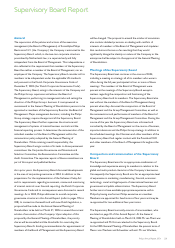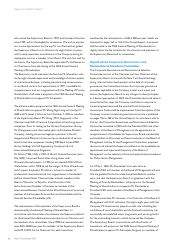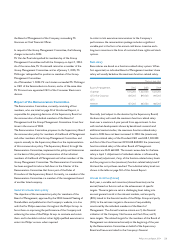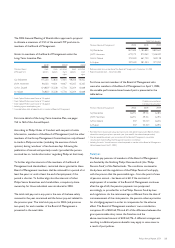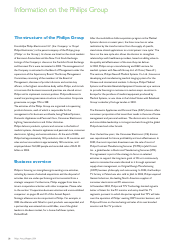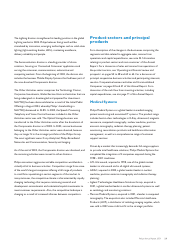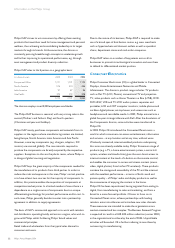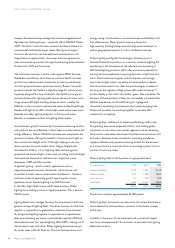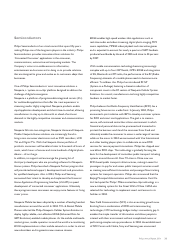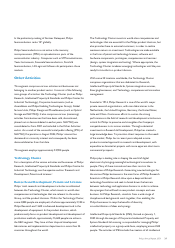Philips 2004 Annual Report Download - page 31
Download and view the complete annual report
Please find page 31 of the 2004 Philips annual report below. You can navigate through the pages in the report by either clicking on the pages listed below, or by using the keyword search tool below to find specific information within the annual report.As a result of the integration, Philips Medical Systems has
accelerated time-to-market of new products and systems.
Whereas in 2002 some 40% of our sales were due to products
younger than 2 years, in 2004 this number has grown to
approximately 60%. Among the key products are the 64-slice
Brilliance CT, which allows very detailed images of the beating
heart, and the world’s first high-speed, truly open, whole-body 1
Tesla MR scanner.
For cardiovascular intervention, Medical Systems introduced a flat
detector X-Ray system, with the highest resolution for the
diagnosis and treatment of disease in complex arterial structures
such as in the brain.
New Ultrasound systems with voice control were introduced for
general radiology and for cardiology; according to research on
behalf of the Society of Diagnostic Medical Sonographers, they are
the best on the market today. These systems are ergonomically
designed for the reduction of neck and shoulder stress of users.
For early and accurate diagnosis of cancer and heart disease the
division launched the world’s first high-end SPECT-CT scanner
with its new Precedence system. This system and the new PET-CT
with 16-slice Brilliance CT are also critical for the molecular
imaging program and expand the basis for research collaborations
in molecular imaging. By combining new molecular agents with
advanced imaging tools, molecular imaging is expected to create a
paradigm shift in healthcare by providing insight into specific
molecular pathways in the body. Instead of conventional treatment
of diseases at later stages of disease development, molecular
imaging may lead to detection, diagnosis and treatment at the
earliest stages of disease development with potentially far-reaching
influence on patient outcomes and cost.
Medical Systems is also expanding its customer financing business.
In the USA, Philips Medical Capital, a venture with the Rabobank
Group’s subsidiary De Lage Landen International, has increased
the amount of business financed by 25% during 2004. In Europe
the division has partnered with Société Générale to establish
Philips Medical Capital in Germany, the United Kingdom, France,
Italy, Spain and the Netherlands.
As part of Philips’ expansion plan for Asia, in 2004 Medical Systems
established a manufacturing venture with Neusoft in China, for the
development and worldwide supply of imaging equipment.
In parallel, an expansion plan in Healthcare IT has been executed
through a non-equity alliance with Epic Systems, a US-based
leading enterprise IT company, in 2003.
The alliance with Epic allows Philips to offer enterprise-wide
Healthcare IT systems that seamlessly integrate with its
best-in-class clinical IT systems for departments such as radiology,
cardiology, critical and emergency care, and radiation oncology. In
parallel, Medical Systems’ plan to move to a common IT
architecture for workstations, departmental, enterprise systems
and user interface has made significant progress, and the new
systems now launched feature the same consistent Philips User
Interface.
During 2004 a series of strategic partnership deals were closed
with many of the USA’s top hospitals (as ranked by the US-based
magazine ‘US News & World Report’ on hospital systems), such as
University of Chicago hospital. Full-range, multi-year contracts
were agreed with other organizations as well. The largest order
was made by Premier Purchasing of the USA, which awarded
Philips (as one of two companies) a three-year, approximately
USD 2 billion agreement for the full line of imaging modalities and
related services.
These developments have further strengthened the division’s
position and reputation in the markets around the world, and have
led to an increase of its global market share in 2004. The
completion of the process of integrating the acquired companies
has resulted in a significantly wider coverage of the Philips brand to
important target audiences such as cardiology sub-specialities,
radiology sub-specialties (ultrasound and nuclear medicine), as well
as critical care practitioners and emergency medicine specialists.
The new brand positioning of Philips is expected to be both very
relevant and differentiating for Medical Systems, and the new
medical products function as proof-points in the worldwide
corporate campaign.
Medical Systems’ strategy is aimed at maintaining its worldwide
leadership positions in cardiology and critical care, while
continuing to expand in radiology and Healthcare IT. The division
seeks to achieve this by accelerating time-to-market of new
products. In Healthcare IT, the Company has made an alliance with
Epic to offer a broad suite of enterprise solutions. In parallel, a
program is under way to build multi-year alliances with leading
hospitals around the world to develop next-generation medical
procedures and new applications.
Further expansion plans are being developed to improve
important care cycles such as acute, cardiovascular and oncology
care.
MedQuist, a majority participation which was acquired in 2000,
holds an important position in outsourced medical record
transcription services in the US.
30 Philips Annual Report 2004
Information on the Philips Group



